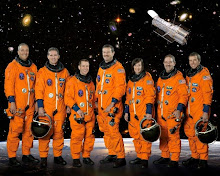- To orbit a manned spacecraft around Earth;
- To investigate man's ability to function in space;
- To recover both man and spacecraft safely.
Mercury-Redstone 3 FREEDOM 7
May 5, 1961 Alan B. Shepard, Jr.
15 minutes, 28 secondsSuborbital flight that successfully put the first American in space.

Launch of Freedom 7, the first American manned suborbital space flight. Astronaut Alan Shepard aboard, the Mercury-Redstone (MR-3) rocket is launched from Pad 5. NASA Image.
Mercury-Redstone 4 LIBERTY BELL 7
July 21, 1961 Virgil I. Grissom
15 minutes, 37 secondsAlso suborbital; successful flight but the spacecraft sank shortly after splashdown.

Prior to his own historic mission Astronaut Virgil I. "Gus" Grissom checks the installation of the periscope from which astronaut Alan B. Sheppard, Jr. viewed the Earth on his historic ride into space in the Freedom 7 space capsule. NASA Image
Mercury-Atlas 6 FRIENDSHIP 7
February 20, 1962John H. Glenn, Jr.
04 hours, 55 minutes 23 seconds Three-orbit flight that placed the first American into orbit.

Overall view of astronaut John Glenn, Jr., as he enters into the spacecraft Friendship 7 prior to MA-6 launch operations at Launch Complex 14. Astronaut Glenn is entering his spacecraft to begin the first American manned Earth orbital mission. NASA Image.
Mercury-Atlas 7 AURORA 7
May 24, 1962 M. Scott Carpenter
04 hours, 56 minutes, 5 seconds Confirmed the success of Mercury-Atlas 6 by duplicating flight.

Inside Hangar S at the White Room Facility at Cape Canaveral, Florida, Mercury astronaut M. Scott Carpenter examines the honeycomb protective material on the main pressure bulkhead (heat shield) of his Mercury capsule nicknamed "Aurora 7." NASA Image.
Mercury-Atlas 8 SIGMA 7
October 03, 1962 Walter M. Schirra, Jr.
09 hours, 13 minutes, 11 secondsSix-orbit engineering test flight.

Astronaut Walter M. Schirra Jr. in Mercury pressure suit with model of Mercury capsule behind him. NASA Image.
Mercury-Atlas 9 FAITH 7
May 15-16, 1963L. Gordon Cooper, Jr.
34 hours, 19 minutes, 49 secondsLast Mercury mission; completed 22 orbits to evaluate effects of one day in space.

Astronaut L. Gordon Cooper in white room, waiting for Terminal Countdown Demonstrations Test (TCDT) activities to resume in preparation for his Mercury- Atlas 9 launch. NASA Image.
Spaceman.







